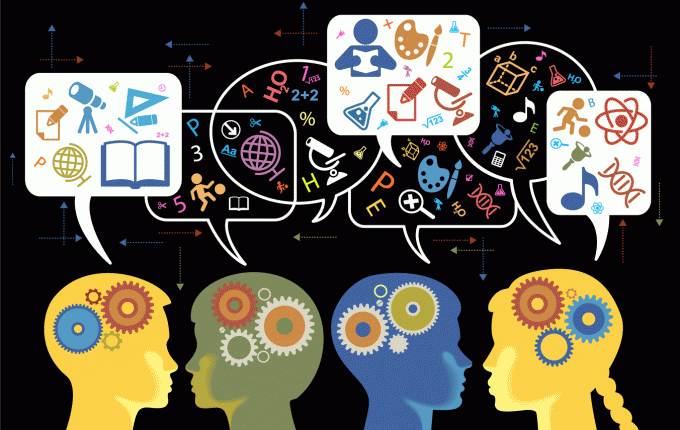Walt Disney saw a theme park while standing in a swamp. Michelangelo saw “The David” in a block of marble. Were these instances of developed imagination or flukes of fate?
Imagination is defined as the ability to form new images and sensations that are not perceived through sight, hearing, or other senses. Current brain research reveals some startling data.
- MRI studies
- The use of imagination fires up multiple areas of the human brain with increased blood flow. (Neuronal activity is connected to blood flow.)
- Brain areas associated with complex problem-solving become activated during daydreaming or imaginative episodes.
- Neurology research:
- Imagination helps make knowledge applicable when solving problems.
- Imagination is fundamental to integrating experience and to the learning process.
With imagination packing such power, why is it so often underrated?
“Quit daydreaming and get back to work!” Ever heard that one? Studies from the field of Humanistic Psychology found numerous examples of people in creative or artistic careers—musical composers, novelist, filmmakers, etc., developing new ideas through daydreaming. Perhaps that’s understandable in the creative arts, yet surprisingly, the same phenomenon occurred with scientists and mathematicians who daydreamed about their subject areas.
For fear that children might be sucked into neurosis or psychosis, some educational psychologists in the 1950’s warned parents to not let their children daydream. Yet, current research from this field shows that daydreaming, much like nighttime dreaming, is a time when the brain consolidates learning.
Are the genius-level imaginations of Michelangelo, Walt Disney, and Albert Einstein gifts reserved for a special few? …or can such imaginative skills be developed? While the use of imagination may come more naturally to some people, I believe imagination can be developed, nurtured and coaxed into flying just as surely as a fledging baby bird. Like honing any skill, it’s a matter of practice.
With today’s fast-paced schedules, children’s days are crammed with school and extracurricular activities—sports, karate, piano, violin, etc. — and then homework, chores, hygiene duties, etc. All worthy pursuits, but are today’s kids getting enough imagination time? Are they having moments of wonder where sticks suddenly become magic wands, where inner tubes become space ships, where small flashlights ensconced in the folds of pockets transform into powerful lasers, where an accidental spill becomes a science experiment? …enchanting moments where their worlds expand, where their self-concepts are elevated, and where possibilities are infinite?
Einstein valued imagination and used it intentionally in his work. Parents can help their children develop this resource and it may be easier than you think.
- Imagination — Basic Training:
- Research shows that simply “listening to storytelling (narrative) where carefully-chosen words evoke different realities” is the most effective tool to develop imagination. Pair an intriguing story with visually rich illustrations and children can easily occupy another world, both mentally and emotionally.
- Imagination — Boot Camp:
- Provide a daily dose of intriguing storybooks, including next generation ebooks like EggMania: Where’s the Egg in Exactly?
- Participate with children in creating their own tales of fantasy by using an ad-lib or IMPROV style with each person contributing a sentence or two in round-robin fashion.
- Repurpose everyday household objects, encouraging kids to think of varying uses for them.
- View art, encouraging kids to see shapes and symbols other than what is obvious. Ask kids to imagine that if the painting extended beyond the frame, what images would be depicted on the right, the left and/or the bottom and the top.
- Cloud watch — when in the car or outdoors, look at the clouds and their morphing shapes, naming what they resemble. Create stories based upon the evoked images.
- Pretend Games: “You have a twin on another planet.” What is their life like? Have kids brainstorm / describe / draw family vacations and summer camps for their alien twin. Create an alien-twin fantasy diorama where the entire family participates.
- Stimulate creativity: Give older kids three household objects or kitchen items (safe ones with no sharp edges) and ask them to create a story, poem, sitcom characters, reality TV show script, game idea, or cartoon based upon those items.
- Play “Project into the Future.” What are the possibilities? Stay positive here, no doom-and-gloom prophecy permitted.
- Ensure that kids have some downtime—time to just be, time to daydream, and time to space out.
Walt Disney said, “Mickey Mouse popped out of my mind onto a drawing pad 20 years ago on a train ride from Manhattan to Hollywood at a time when business fortunes of my brother Roy and myself were at lowest ebb and disaster seemed right around the corner.” Just think, the Disney Empire all started with a casual sketch of a mouse! I must wonder how many fortunes have never been made due to the suppression of imagination. How many such imaginings and ideas have been tossed into a wastebasket or discounted as diddle-doodle daydreams?
Let the magic happen; allow your child’s brain to brim with ideas. Most importantly, allow the expression of those ideas. Value the power of imagination. Reap the benefits.
